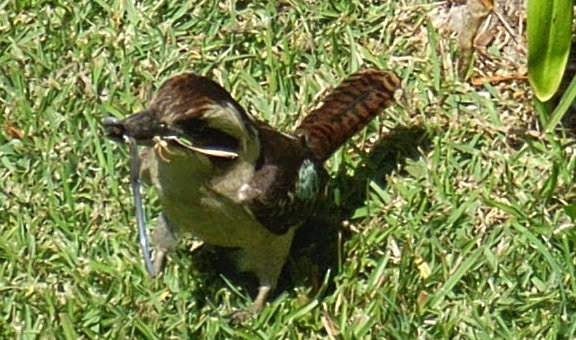 |
| keeping my yard free from snakes |
My Sisters stayed over for the weekend. They were tossing
bits of meat down to my Burra’s, and noticed one feeding the other. I pointed
out that this is unusual as they haven’t done that since Bully & Brave Baby
fledged back in Feb. I then Googled it and found this from the San Diego Zoo;
 |
| Boy Kooka - Blue bum |
Courtship involves three elements (Myers 1996):
o Courtship feeding;
male brings food to female § Other group members may also bring food (Legge 2004)
o Time spent visiting the nest in a tree hollow
o Copulation
So, I’m expecting to hear the fitter-fatter of little wings in a few months.
 |
| Girl Kooka - Brown bum |
This will be a bittesweet moment for me as I will probably be losing a couple from my family.
o Females will usually immediately join another group, filling a vacancy with a dominant, breeding male
o Occasionally a male and female from different groups will make a partnership and establish a new territory of their own
· Male helpers typically leave later, after an average of two seasons (Legge 2004)
Boss (male) & Bashful (female) are the original pair from 3 years ago. Bitey (male) fledged ’13, Bully (female) & Brave (??) this Jan. There is also an Aunt/Uncle that rarely comes in for a feed.
So who stays and who goes? Only time will tell.
What was interesting last weekend was that it was Bitey
feeding Bully, I think? I say I think, as they all look the same. It’s getting harder to tell their personalities as with
age they are learning from each other. I’m am trying to get as many photos as
possible to see if they have unique wing patterns, or maybe the width of their
crown.
 |
| swoosh to the left |
Which leads to the next 3 photos. Ever wonder how a
Kookaburra does his hair?
 |
| one to the right |
 |
| 1 more & we're good to go |
I am a lot more attentive to things my Burra’s do since starting
this blog, so I think I’m up for an interesting period.
Boss turned up this week for a feed & a pat. This gave
me the opportunity to have a closer look at his wound. The following vid is how
he is progressing. It starts with his original wound then his following 3
inspections.
| http://youtu.be/kjyNX5PuXm0 |
Later in the week, a bug landed on my veranda rail
(seriously bad move).
Now, here’s a photo op if I ever saw one. |
| short life expectancy |
I placed a piece of meat near the bug to get Boss’s
attention. He landed & grabbed the meat, yet didn’t notice the bug.
I pointed to the bug and he didn’t notice.
 |
| You're kidding me |
 |
| Bum prod. |
Boss wasn’t interested in the bug until it moved.
I can only think that’s the benefit of camouflage. I thought initially maybe it can’t see it because it’s not moving (Jurassic Park moment), but the meat and stuff I feed them is stationary, so it’s not that.
Here is the video.
Next was my “tongue project”. I had caught a photo of a
“Noisy Miner” sticking his tongue out and thought – what does a Kookaburra
tongue look like. Well not like that of a Miner that’s for sure.
It’s very short & arrow shaped. I suspect when they
strike, they close it against the roof of their mouth closing off their throat,
then lower it onto their prey. The rear facing parts of the arrow hooking any
legs etc.
 |
| no birds were hurt in bringing you this blog can't say the same for my fingers |
I was checking some photos prior to deleting and noticed
these two.
 When I looked closely, it was a wake up moment. Look at the
aerodynamics involved.
When I looked closely, it was a wake up moment. Look at the
aerodynamics involved.
In the 1st photo, check how he has raised his nape
feathers. This would direct the flow of air straight to his tail – I think they
use their tail not only as a brake, but to right them on landing. Now look at
the wings. Not only are they the major brake (sort of reverse thrust), it
appears they’re funnelling air to under its body.
Now look at the 2nd photo and check the feathers around his
bum. Notice how they’re standing up in rows. Another set of brake's I suspect.
And there is probably more going on that I can’t see.
I can’t wait for next week.

















